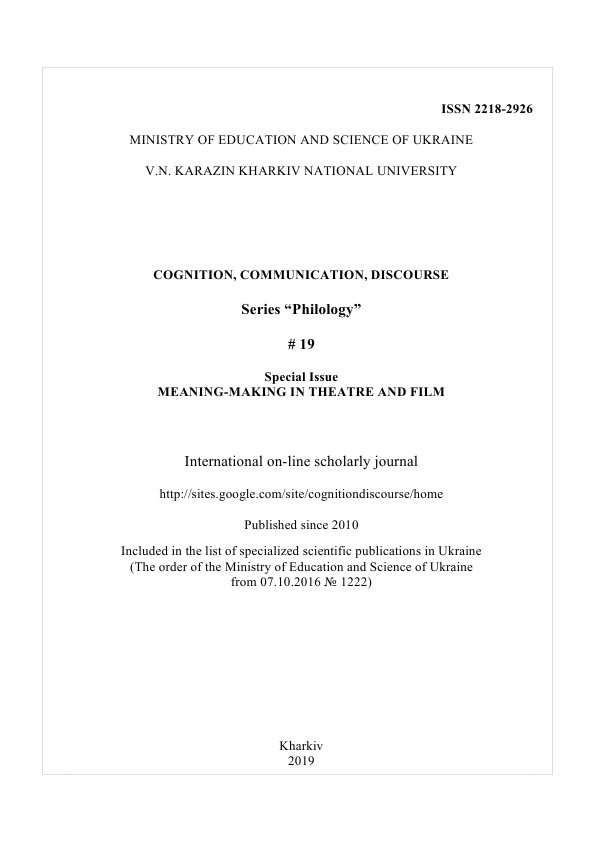The textual issues of meaning-making in theatre and film: a semiotic introduction
Abstract
The textual issues of meaning-making in theatre and film: a semiotic introduction
Downloads
References
Bakhtin, M. (1981). Forms of time and of the chronotope in the novel. In M. Holquist (Ed.) The Dialogic Imagination. Four Essays by M. M. Bakhtin (Emerson, C., & Holquist, M. Trans.) (pp. 84–258). Austin, TX: University of Texas Press.
Bakhtin, M.(2002). Rabochie zapisi 1960 – nachala 1970 godov [Notes from 1960s – beginning 1970s]. In M. Bakhtin.Sobranie sochinenii v 7 tomah [Collected works in 7 volumes]. (Vol. 6) (pp. 371–439). Moscow: Russkie slovari, Jazyki slavjanskoi kultury,.
Bakhtin, M.(2012). Razroznennye listy k «Formam vremeni i hronotopa...» [Scattered sheets to “Forms of time and of the chronotope”]. In M. Bakhtin. Sobranie sochinenii v 7 tomah (Collected works in 7 volumes).(Vol.3) (pp. 504–511). Moscow: Jazyki slavjanskih kultur.
Eco, U.(2001). Experiences in Translation (A. McEwen Transl.). Toronto–Buffalo–London: University of Toronto Press.
Esslin, M. (1987). The Field of Drama: How the Signs of Drama Create Meaning on Stage and Screen. London, Auckland, Melbourne, Singapore, Toronto: Methuen Drama.
Fischer-Lichte, E. (2008). Semiotic and Performative Dimensions of Theatre. Journal of Dramatic Theory and Criticism, 22(2), 69–81.
Holquist, M.(1994). Dialogism: Bakhtin and His World. London: Routledge.
Hven, S.(2017). Cinema and Narrative Complexity: Embodying the Fabula. Amsterdam: Amsterdam University Press.
Jakobson, R. (1971). Linguistics in Relation to Other Sciences. In R.Jakobson. Selected Writings. (Vol 2). Word and Language (pp. 655–695). The Hague, Paris: Mouton.
Jenkins, H. (2006). Convergence Culture. Where Old and New Media Collide. New York, London: New York university Press.
Keunen, B. (2010). The Chronotopic Imagination in Literature and Film: Bakhtin, Bergson and Deleuze on Forms of Time. In N. Bemong, P. Borghart, M. De Dobbeleer, K. Demoen,
K. De Temmerman & B. Keunen (Eds.). Bakhtin's Theory of the Literary Chronotope: Reflections, Applications, Perspectives (pp.35–55). Gent: Academia Press.
Lotman, J. (1988). The semiotics of culture and the concept of a text. Soviet Psychology, 26(3),
52–58.
Lotman, J. (1992). Text i poliglotizm kultury [Text and cultural polyglotism]. In J. Lotman. Izbrannye statji. (Vol .I). Statji po tipologii kultury (pp. 142–147). Tallinn: Aleksandra.
Manovich, L.(2001). The Language of New Media. London, Cambridge: The MIT Press.
Morson, G. S., & Emerson, C. (1990). Mikhail Bakhtin: Creation of a Prosaics. Stanford: Stanford University Press.
Pearson, R., & Smith, A. N. (2015). Storytelling in the Media Convergence Age: Exploring Screen Narratives. Basingstoke, New York: Palgrave Macmillan.
Pethö, Á. (2010). Intermediality in Film: A Historiography of Methodologies. Film and Media Studies, 2, 39–72.
Torop, P.(2000). Intersemiosis and intersemiotic translation. European Journal for Semiotic Studies, 12(1), 71–100.
Torop, P. (2019). Cultural languages and value of chronotopical analysis. In J. Haidar & I. B. Ramos (Eds.). Fronteras semióticas de la emoción. Los procesos del sentido en las culturas. Libro homenaje a Desiderio Navarro (pp. 63–92). Mexico: ENAH, UNAM, 2018.
Wildfeuer, J. (2014). Film Discourse Interpretation: Towards a New Paradigm for Multimodal Film Analysis. New York, London: Routledge.
Copyright (c) 2019 Torop Peeter

This work is licensed under a Creative Commons Attribution-NonCommercial-NoDerivatives 4.0 International License.
Authors, who publish with this journal, accept the following conditions:
The authors reserve the copyright of their work and transfer to the magazine the right of the first publication of this work under the terms of the Creative Commons Attribution Non-Commercial Non-Derivs License (CC BY-NC-ND), which allows other persons to freely distribute a published work with mandatory reference to the authors of the original work and the first publication of the work in this journal.
Authors have the right to enter into separate additional agreements for the non-exclusive dissemination of the work in the form in which it was published by this journal (for example, to post the work in the electronic institutions' repository or to publish as part of a monograph), provided that the link to the first publication of the work in this journal is given.
The journal policy allows and encourages the authors to place the manuscripts on the Internet (for example, in the institutions' repositories or on personal websites), both before the presentation of this manuscript to the editorial board and during review procedure, as it contributes to the creation of productive scientific discussion and positively affects the efficiency and dynamics of citing the published work (see The Effect of Open Access).




